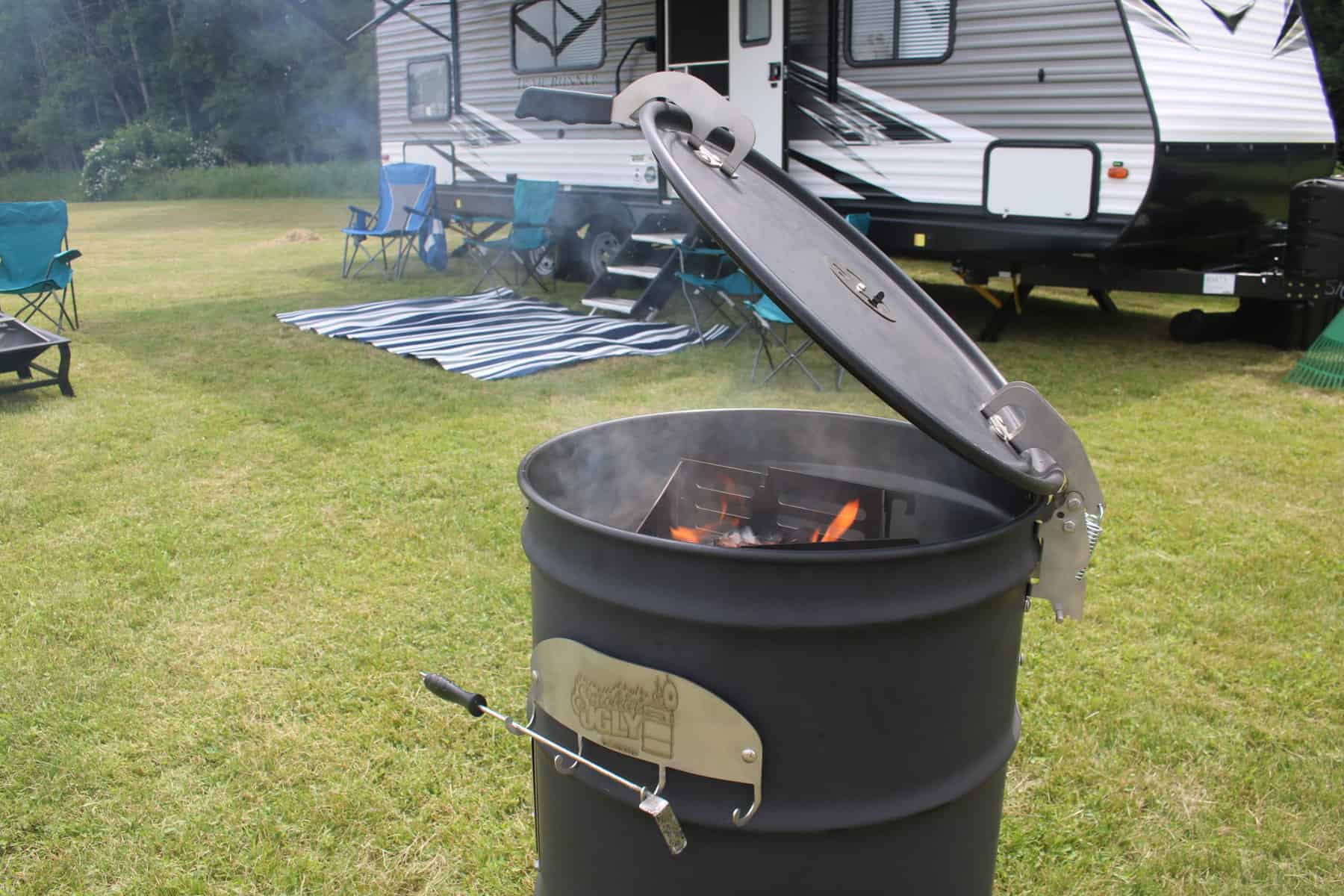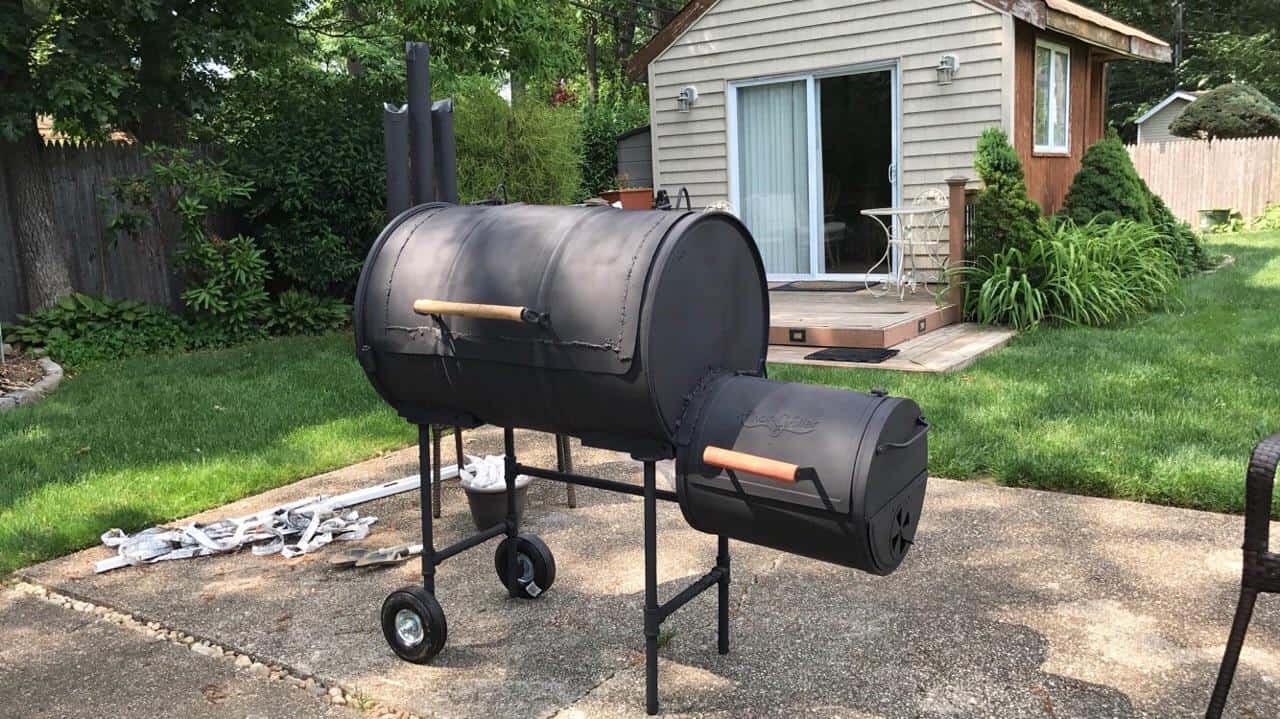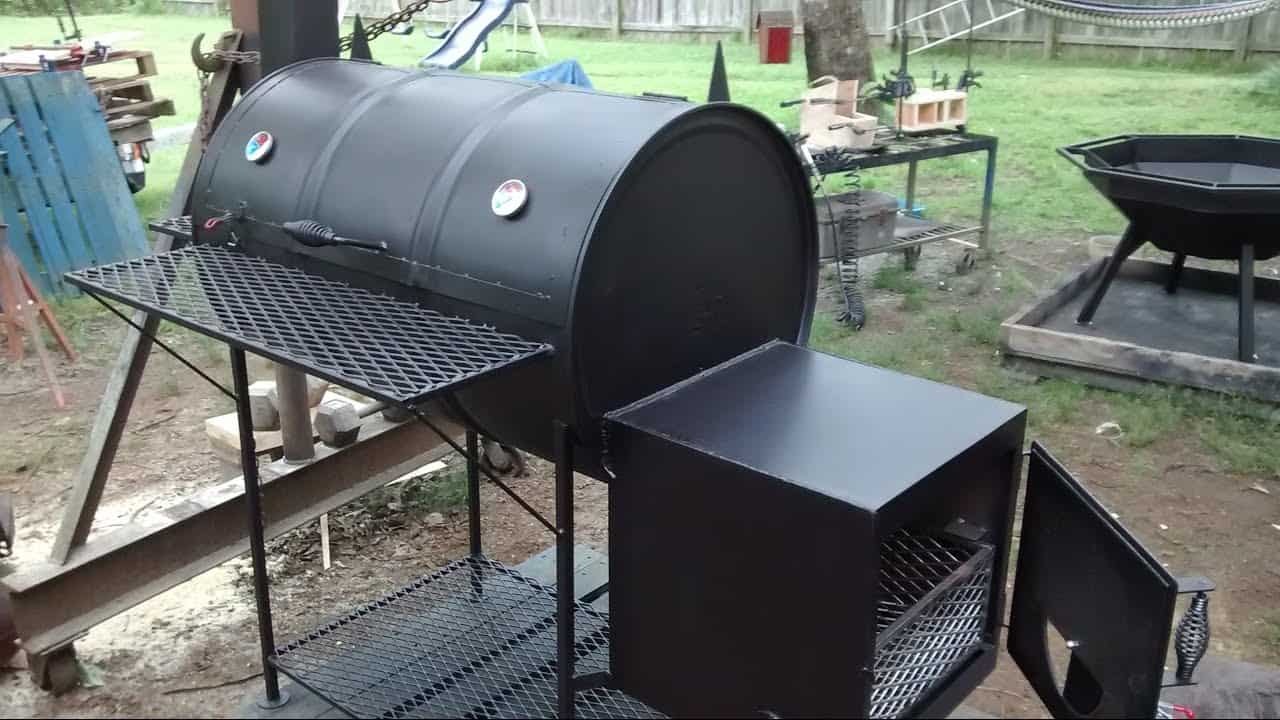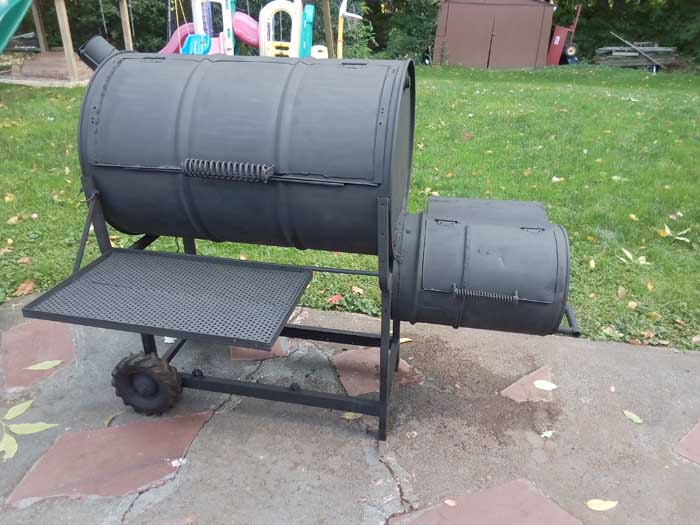How to build Barrel Smoker? To build a barrel smoker, cut the barrel vertically, add hinges for the lid, install racks for the food, attach vents for airflow, and incorporate a firebox at the bottom, ensuring proper sealing and insulation for effective smoking.
Smokin’ Hot Tips: How to Build Your Own Barrel Smoker
Building your own barrel smoker can be a rewarding and cost-effective way to enjoy the art of smoking meat. There are several benefits to building your own smoker, including the satisfaction of creating something with your own hands and the cost savings compared to buying a pre-made smoker.
One of the main benefits of building your own barrel smoker is the satisfaction that comes with creating something from scratch. Building a smoker allows you to customize it to your specific needs and preferences. You can choose the size, shape, and design that works best for you. Additionally, building your own smoker gives you a sense of accomplishment and pride in knowing that you created something functional and unique.
Another advantage of building your own barrel smoker is the cost savings. Pre-made smokers can be quite expensive, especially if you’re looking for a high-quality one. By building your own smoker, you can save money on the cost of materials and labor. Plus, you have the freedom to choose affordable materials without compromising on quality.
Choosing the Right Barrel for Your Smoker
When it comes to choosing the right barrel for your smoker, there are a few factors to consider. First, you’ll want to decide on the type of barrel you want to use. There are several options available, including steel drums, oil barrels, and wine barrels. Each type of barrel has its own advantages and disadvantages, so it’s important to do your research and choose one that suits your needs.
Next, you’ll need to consider the size and shape of the barrel. The size of your smoker will depend on how much food you plan on smoking at once. If you’re planning on smoking large cuts of meat or hosting big gatherings, you’ll want a larger barrel. On the other hand, if you’re only planning on smoking for yourself or a small group, a smaller barrel will suffice.
Once you’ve decided on the type, size, and shape of the barrel, you’ll need to find a suitable one. You can often find barrels for sale at local hardware stores, online marketplaces, or even salvage yards. It’s important to choose a barrel that is in good condition and free from any chemicals or residues that could contaminate your food.
Tools and Materials You Will Need
Building your own barrel smoker will require a few tools and materials. Here is a list of the necessary items:
– Barrel: As mentioned earlier, you’ll need to choose a suitable barrel for your smoker.
– Angle grinder: This tool will be used for cutting and shaping the barrel.
– Welding machine: If you plan on welding the barrel together, you’ll need a welding machine.
– Drill: A drill will be needed for creating holes for ventilation and attaching accessories.
– Thermometer: A thermometer is essential for monitoring the temperature inside the smoker.
– Grates and racks: You’ll need grates and racks to hold your food while it smokes.
– Insulation materials: If you want to insulate your smoker for optimal heat retention, you’ll need insulation materials such as fiberglass or ceramic wool.
When sourcing materials and tools, it’s important to shop around and compare prices. You may be able to find some items at a lower cost by looking for sales or purchasing used equipment. Additionally, it’s important to prioritize safety when working with tools and materials. Always wear protective gear such as gloves, goggles, and a mask when necessary.
Step-by-Step Guide to Building Your Barrel Smoker
Now that you have all the necessary tools and materials, it’s time to start building your barrel smoker. Here is a step-by-step guide to help you through the process:
1. Prepare the barrel: Clean the barrel thoroughly to remove any dirt or debris. If necessary, sand down any rough edges or rust spots.
2. Mark and cut the openings: Use a marker to mark the locations for the openings you’ll need, such as the door, ventilation holes, and chimney. Use an angle grinder to carefully cut out these openings.
3. Weld the door: If you’re using a barrel with a removable lid, you’ll need to weld a door onto the barrel. Cut out a section of the barrel to create the door and use a welding machine to attach it securely.
4. Create the firebox: Cut out a section of the barrel to create the firebox. This is where you’ll place your charcoal or wood for smoking. Make sure to leave enough space for proper airflow.
5. Install ventilation system: Drill holes in strategic locations to allow for proper ventilation. This will help control the temperature inside the smoker.
6. Attach grates and racks: Use bolts or welding to attach grates and racks inside the smoker. Make sure they are securely fastened and evenly spaced.
7. Insulate the smoker (optional): If you want to insulate your smoker for optimal heat retention, wrap insulation materials around the barrel and secure them with wire or metal bands.
8. Season the smoker: Before using your smoker for the first time, it’s important to season it. This involves coating the interior with cooking oil and heating it at a high temperature to create a protective layer.
Tips for Cutting and Welding Your Barrel
Cutting and welding your barrel can be one of the most challenging parts of building your own smoker. Here are some tips to help you through this process:
1. Measure twice, cut once: Before making any cuts, double-check your measurements to ensure accuracy. It’s better to take your time and be precise than to rush and make mistakes.
2. Use a steady hand: When cutting with an angle grinder, it’s important to have a steady hand and maintain control of the tool. Take your time and make slow, deliberate cuts.
3. Wear protective gear: Cutting and welding can produce sparks and debris, so it’s important to wear protective gear such as gloves, goggles, and a mask. This will help protect you from potential injuries.
4. Practice proper welding techniques: If you’re new to welding, it’s a good idea to practice on scrap metal before working on your barrel. This will help you get a feel for the process and improve your skills.
5. Ensure a secure and leak-proof seal: When welding the door or attaching accessories, make sure to create a secure and leak-proof seal. This will prevent smoke from escaping and ensure proper airflow.
Creating the Firebox and Ventilation System
The firebox and ventilation system are crucial components of your barrel smoker. Here are some tips for creating a well-designed firebox and ventilation system:
1. Choose the right size firebox: The size of your firebox will depend on the amount of food you plan on smoking. It should be large enough to hold an adequate amount of charcoal or wood, but not too large that it affects the airflow inside the smoker.
2. Create proper airflow: Proper airflow is essential for maintaining consistent temperatures inside the smoker. Make sure to create ventilation holes in strategic locations to allow for air intake and smoke exhaust.
3. Use adjustable vents: Consider using adjustable vents to control the airflow and temperature inside the smoker. This will give you more control over the smoking process and allow you to make adjustments as needed.
4. Position the firebox correctly: The firebox should be positioned in a way that allows for efficient heat transfer to the smoking chamber. It should be located directly below or adjacent to the smoking chamber for optimal heat distribution.
5. Test for proper airflow: Before using your smoker, test for proper airflow by lighting a small fire in the firebox and observing how the smoke travels through the ventilation system. Make any necessary adjustments to ensure proper airflow.
Adding Grates and Racks for Smoking Meat
Adding grates and racks to your smoker is essential for holding your food while it smokes. Here are some tips for adding grates and racks:
1. Choose the right size and material: Grates and racks come in various sizes and materials, such as stainless steel or cast iron. Consider the size of your smoker and the type of food you plan on smoking when choosing grates and racks.
2. Space them evenly: When adding grates and racks, make sure to space them evenly to allow for proper airflow and heat distribution. This will ensure that your food cooks evenly and is not overcrowded.
3. Use different types of grates and racks: Consider using different types of grates and racks to accommodate different types of food. For example, a flat grate is ideal for smoking vegetables, while a rib rack is perfect for smoking ribs.
4. Secure them properly: Whether you’re using bolts or welding to attach the grates and racks, make sure they are securely fastened. This will prevent them from shifting or falling during the smoking process.
Insulating Your Barrel Smoker for Optimal Heat Retention
Insulating your barrel smoker can help improve heat retention and overall performance. Here are some tips for insulating your smoker:
1. Choose the right insulation materials: There are several insulation materials available, such as fiberglass or ceramic wool. Consider the temperature range you plan on smoking at and choose an insulation material that can withstand those temperatures.
2. Wrap the insulation materials tightly: When wrapping the insulation materials around the barrel, make sure to do so tightly to create a snug fit. This will help prevent heat from escaping and maintain consistent temperatures inside the smoker.
3. Secure the insulation materials properly: Use wire or metal bands to secure the insulation materials in place. This will prevent them from shifting or falling off during the smoking process.
4. Test for heat retention: Before using your smoker, test for heat retention by lighting a small fire in the firebox and monitoring the temperature inside the smoker. Make any necessary adjustments to ensure optimal heat retention.
Seasoning Your New Smoker for the First Time
Seasoning your smoker is an important step that helps create a protective layer and enhances the flavor of your food. Here’s how to season your smoker for the first time:
1. Clean the interior: Before seasoning, clean the interior of your smoker to remove any dirt or debris. This can be done by wiping it down with a damp cloth or using a mild detergent if necessary.
2. Coat the interior with cooking oil: Use a brush or cloth to coat the interior of your smoker with cooking oil. Make sure to cover all surfaces, including the grates and racks.
3. Heat the smoker: Light a small fire in the firebox and allow it to burn for several hours. This will help cure the oil and create a protective layer on the interior surfaces.
4. Monitor the temperature: During the seasoning process, monitor the temperature inside the smoker to ensure it stays within a suitable range. This will help prevent any damage or warping to the smoker.
5. Repeat as necessary: Depending on the type of oil used and the desired level of seasoning, you may need to repeat this process multiple times before your smoker is fully seasoned.
Smoking Techniques and Recipes for Your Barrel Smoker
Now that your barrel smoker is built and seasoned, it’s time to start smoking some delicious food. Here are some different smoking techniques to try:
1. Low and slow: This is a classic smoking technique that involves cooking food at a low temperature (around 225°F) for an extended period of time. This method is ideal for large cuts of meat, such as brisket or pork shoulder.
2. Hot and fast: This technique involves cooking food at a higher temperature (around 300°F) for a shorter period of time. It’s great for smaller cuts of meat, such as ribs or chicken wings.
3. Cold smoking: Cold smoking is a technique used to add a smoky flavor to foods without cooking them. It involves smoking food at temperatures below 100°F for an extended period of time. This method is commonly used for smoking cheese or fish.
When it comes to recipes, the possibilities are endless. Here are a few ideas to get you started:
– Smoked brisket: Rub a beef brisket with your favorite seasoning blend and smoke it low and slow until it reaches an internal temperature of 195°F.
– Smoked salmon: Brine a salmon fillet overnight, then smoke it at a low temperature until it’s cooked through and has a smoky flavor.
– Smoked vegetables: Toss your favorite vegetables in olive oil, salt, and pepper, then smoke them until they’re tender and have a smoky flavor.
Maintenance and Cleaning Tips for Your Barrel Smoker
To keep your barrel smoker in optimal condition, regular maintenance and cleaning are necessary. Here are some tips to help you maintain and clean your smoker:
1. Clean the grates and racks: After each use, remove the grates and racks from the smoker and clean them thoroughly with warm soapy water. Use a brush or sponge to scrub off any residue or stuck-on food.
2. Remove ash and debris: After each use, remove any ash or debris from the firebox and ventilation system. This can be done by using a brush or vacuum cleaner specifically designed for ash removal.
3. Check for rust or damage: Regularly inspect your smoker for any signs of rust or damage. If you notice any issues, address them immediately to prevent further damage.
4. Store your smoker properly: When not in use, store your smoker in a dry and covered area to protect it from the elements. This will help prolong its lifespan and prevent rust or damage.
5. Season your smoker regularly: Over time, the seasoning on your smoker may wear off. To maintain optimal flavor and protection, season your smoker regularly by following the steps outlined earlier.
By following these maintenance and cleaning tips, you can ensure that your barrel smoker remains in great condition and continues to produce delicious smoked food for years to come.
In conclusion, building your own barrel smoker can be a rewarding and cost-effective way to enjoy the art of smoking meat. By choosing the right barrel, gathering the necessary tools and materials, and following a step-by-step guide, you can create a functional and unique smoker that suits your needs. With proper maintenance and cleaning, your barrel smoker will provide you with years of delicious smoked food and enjoyable cooking experiences. So why not give it a try and start building your own barrel smoker today?
Originally posted 2024-02-07 01:52:40.




